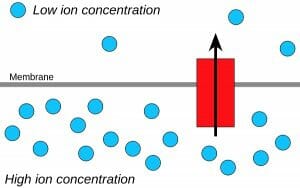Chemiosmosis Definition
Chemiosmosis is when ions move by diffusion across a semi-permeable membrane, such as the membrane inside mitochondria. Ions are molecules with a net electric charge, such as Na+, Cl–, or specifically in chemiosmosis that generates energy, H+. During chemiosmosis, ions move down an electrochemical gradient, which is a gradient of electrochemical potential (a form of potential energy). Since chemiosmosis is a type of diffusion, ions will move across a membrane from areas of high concentration to areas of low concentration. Ions also move to balance out the electric charge across a membrane.
Function of Chemiosmosis
Chemiosmosis is involved in the production of adenosine triphosphate (ATP), which is the main molecule used for energy by the cell. In eukaryotes, ATP is produced through the process of cellular respiration in the mitochondria. First, the molecules NADH and FADH2, obtained from the citric acid cycle, pass electrons down an electron transport chain, which releases energy. This energy allows protons (H+) to travel down a proton gradient via chemiosmosis. This in turn provides the energy for the enzyme ATP synthase to make ATP. The flow of these protons down the gradient turns the rotor and stalk of the ATP synthase, which makes it possible for a phosphate group to join with adenosine diphosphate (ADP), forming ATP. The production of ATP during respiration is called oxidative phosphorylation. Through oxygen and glucose, ATP is ultimately created through the phosphorylation of ADP. In aerobic respiration, 38 ATP molecules are formed per glucose molecule. Since chemiosmosis plays a role in the creation of ATP during this process, without chemiosmosis, organisms would not be able to produce the energy that they need to live.
The idea that ATP is synthesized through chemiosmosis was first proposed in 1961 by Dr. Peter D. Mitchell. At the time, this was controversial, because it was more widely accepted that there was some intermediate molecule that stored energy from the electron transport chain. However, an intermediate molecule was never found, and eventually research showed that the chemiosmosis theory was correct. Mitchell would later go on to win the Nobel Prize in Chemistry in 1976 for his contributions to science.

This images shows, very generally, ions moving from high to low concentration during chemiosmosis.
Examples of Chemiosmosis
Although chemiosmosis is often generally defined as the movement of ions across a membrane, it is really only used in the context of talking about the movement of H+ ions during the production of ATP. The most common method involving chemiosmosis in the production of ATP is cellular respiration in the mitochondria, the process of which is discussed above. All eukaryotic organisms have mitochondria, so chemiosmosis is involved in ATP production through cellular respiration in the vast majority of different types of organisms, from animals to plants to fungi to protists. However, even though archaea and bacteria do not have mitochondria, they also use chemiosmosis to produce ATP through photophosphorylation. This process also involves an electron transport chain, proton gradient, and chemiosmosis of H+, but it takes place across the inner membrane of the bacterium or archaeon, since they have no mitochondria.
Plants produce ATP during photosynthesis in the chloroplast in addition to the ATP they generate through cellular respiration in mitochondria. The process is again similar: during photosynthesis, light energy excites electrons, which flow down an electron transport chain, which in turn allows H+ ions to travel through a membrane in the chloroplast. Some bacteria, such as cyanobacteria, also use photosynthesis.
The similarities between these ATP production methods are more than just coincidence; both mitochondria and chloroplasts are thought to have evolved from free-living bacteria. This theory is called the endosymbiotic theory. This theory hypothesizes that that had symbiotic relationships with other cells, aiding them by producing energy in return for a place to live inside the cell. Over time, these bacteria became inextricable from the cells they resided in. The fact that mitochondria and chloroplasts have their own, separate, DNA supports this idea. This is why the chemiosmosis is used in generally the same way whether ATP is being produced in a mitochondrion, chloroplast, or bacterium.
Related Biology Terms
- Glucose – A simple sugar that has an important role in metabolism and energy production.
- Adenosine triphosphate (ATP) – The main molecule used for energy in cells.
- Ion – A molecule with a net electric charge due to gaining or losing an electron.
- Diffusion – Movement of molecules from an area of high concentration to an area of low concentration.
Quiz
1. Which organism does not have mitochondria?
A. Human
B. Mushroom
C. Bacteria
D. Fern
2. Chemiosmosis involving what ion is part of the process of generating ATP?
A. Na+
B. H+
C. Cl–
D. H–
3. Chemiosmosis can occur in what cell organelle?
A. Mitochondrion
B. Chloroplast
C. Nucleus
D. Choices A and B
